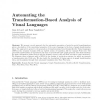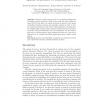191 search results - page 2 / 39 » Transition systems, link graphs and Petri nets |
FAC
2010
13 years 3 months ago
2010
We present a novel approach for the automatic generation of model-to-model transformations given a description of the operational semantics of the source language in the form of gr...
IFIP
2005
Springer
13 years 10 months ago
2005
Springer
Recently, opacity has proved to be a promising technique for describing security properties. Much of the work has been couched in terms of Petri nets. Here, we extend the notion of...
ICALP
2010
Springer
13 years 10 months ago
2010
Springer
We show that the downward-closure of a Petri net language is effectively computable. This is mainly done by using the notions defined for showing decidability of the reachability...
JUCS
2007
13 years 5 months ago
2007
: This paper describes a method of using Petri net P-invariants in system diagnosis. To model this process a net oriented fault classification is presented. Hence, the considered d...
IFIP
1992
Springer
13 years 9 months ago
1992
Springer
This paper presents a completely systematic design procedure for asynchronous controllers. The initial step is the construction of a signal transition graph (STG, an interpreted P...


